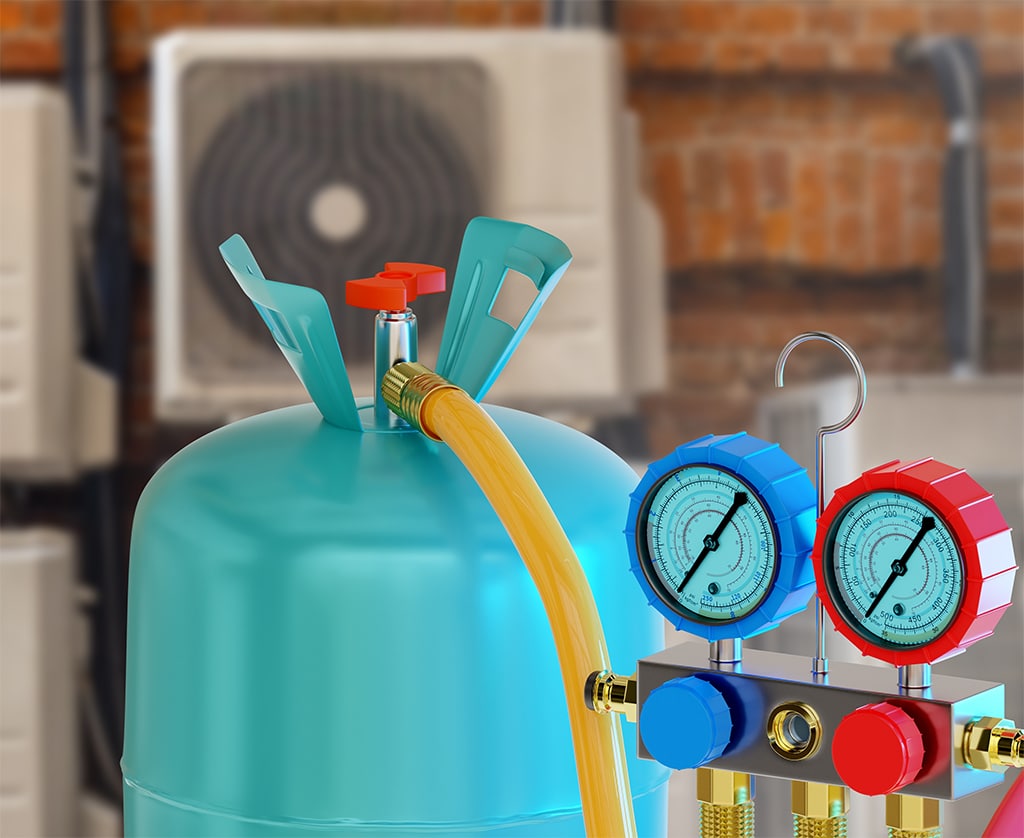
Get Help For Your AC Refrigerant With Reliable Heating And AC Repair | Richardson, TX
The air conditioning system’s refrigerant is the invisible force that facilitates the effective cooling of your home. Heating and AC repair technicians often check your air conditioner’s refrigerant levels. The system must work harder to cool your home if your air conditioner’s refrigerant levels are low. It will also not likely reach your required temperatures. Read on to understand how your air conditioner refrigerant works and also be able to determine when its levels are low and when it’s time to call a heating and AC repair company.
What’s Air Conditioner Refrigerant?
As mentioned above, refrigerant is critical in keeping your home cool and at desired temperatures. It helps with your air conditioner’s cooling function and the freezer, refrigerator, or any other cooling appliance. To know more about an AC refrigerant and its functions, you must first learn how your air conditioner works. The air conditioner uses the refrigerant that runs within copper coils in the condenser and evaporator to absorb the heat from your indoor settings and expel it to the outer environment.
That’s the simplest explanation of a refrigeration cycle. This high-pressure liquid will then blow over with the help of a fan to expel the interior heat to the outer environment. To start the next cycle, the coolant liquid compresses further and rapidly ejects from the special nozzle to change it to gaseous form again. The low-pressure, cold gas then blows over with the help of another fan to inject the cool air into the indoor settings. This cycle repeatedly continues, ensuring that your home is sufficiently cooled.
Ideal Properties of Reliable Coolant
Selecting a refrigerant significantly influences the air conditioning system’s reliability, energy consumption, and safety. Below are some of the ideal properties of a coolant:
Thermodynamic Properties
Thermodynamic features/characteristics, critical temperatures, normal boiling points, and the coolant’s heat capacity should fit the required application for the air conditioner to function seamlessly. Consult a heating and AC repair company on the required thermodynamic properties when purchasing a refrigerant.
Chemical Stability
The other characteristic that a heating and AC repair company must consider before purchasing a coolant is its chemical stability. Although the air conditioner is supposed to serve you for a long time, all its other properties will be pointless should the refrigerant go berserk or decompose within a short time in terms of functionality. It is because your Richardson, TX, home will not be cooled to your desired temperatures.
Impact on Environment, Health, and Safety
A perfect refrigerant should be non-flammable and also have low toxicity. The production of some coolants has since been discontinued because of the environmental impact. Hence, reliable air conditioning service providers and environmentalists recommend using a coolant with the lowest GWP and zero ODP.
Thermo-Physical Properties
The other key characteristic of a suitable refrigerant is its thermophysical properties. Here, properties like high thermal conductivity and low viscosity have an impact on the heat exchanger’s dimensions and, ultimately, the price of the entire air conditioning system. The last set of pertinent criteria describes the components and impacts a system’s long-term reliability. The refrigerant should be compatible with typical construction elements, such as metals and seals.
History of Air Conditioning Refrigerants
A joint effort by Robert McNary, Albert Henne, and Thomas Midgley was the first shot at making an air conditioner refrigerant. While working on the AC division at General Motors (GM), the trio discovered the compounds. The company sought to develop a non-flammable, non-toxic alternative to other refrigerants, such as ammonia and sulfur dioxide. Their refrigerants belonged to the class of chlorofluorocarbon (CFC) coolants, also referred to as Freon refrigerants by brand. The first AC refrigerant was identified as the R-22, an HCFC (hydrofluorocarbon).
Due to its advantageous qualities, it gained widespread use as a coolant in the ensuing decades and became the coolant of choice. HCFCs and CFCs were investigated further in the late 1980s as the world focused on speeding up environmental problems such as global warming. Due to their catastrophic consequences, they were outlawed for destroying the Ozone layer. They were included in the Montreal Protocol’s list of prohibited substances in 1987 and gradually phased away. Heating and AC repair companies in Richardson, TX, don’t use such refrigerants today because of their environmental impacts.
Types of Refrigerants
R22 Refrigerant
R22, also known as Freon, is an HCFC refrigerant that is a chlorofluorocarbon, albeit with an atom of hydrogen, to reduce its duration on the environment. After the CFCs, R22 became common in air conditioning systems in the 1960s. However, it is being phased out by a ban by the EPA. Today, heating and AC repair technicians in Richardson, TX, do not use the refrigerant and advise those with air conditioning systems still using it to replace them. If your air conditioning system was installed before 2010, it most likely used R22. While you might have been able to purchase R22 in the past at a rising cost, it will no longer be available starting in 2020. The EPA prohibits R22 because it is also associated with environmental harm.
Chlorofluorocarbons (CFCs)
CFCs were manufactured by various companies around the year 1995. The CFC refrigerants include R11, R12, and R115, among others. They are deemed not safe for the environment since they contribute to the greenhouse effect and the ozone layer’s depletion. As mentioned above, environmental safety is among the key characteristics of any refrigerant, and CFCs don’t fit the bill. Like R22, the heating and AC repair technicians no longer use chlorofluorocarbon refrigerants.
R410A Refrigerant
As mentioned above, the R22 refrigerant was banned by the EPA. As a result, there was a need for another environmentally friendly coolant, hence the introduction of R410A, commonly called Puron. R410A or Puron is a chlorine-free coolant, meaning it has much less environmental impact than R22. Better yet, it cools your home without losing its cooling characteristics. However, you should consult your heating and AC repair technician, as air conditioners built to use R22 cannot use R410A. This is because Puron has a higher operating pressure.
Additionally, Puron allows a higher SEER rating for heating and air conditioning systems compared to a system that uses Freon. Moreover, it ensures better comfort and higher indoor air quality. With a lower power use and higher SEER, using Puron has the additional benefit of reducing the total demand for power generation plants. Hence, it reduces greenhouse emissions. A high SEER rating means paying less for seasonal energy utility bills. Thus, if you want to save a fortune, contact a heating and AC repair technician to replace your R22 air conditioner with one that uses R410A.
Replacing Freon with Puron
With the government mandating Puron and other eco-friendlier refrigerants, phasing out Freon-based air conditioners has been a considerable concern for various homeowners. If you’re still using an AC unit using Freon, you shouldn’t worry. This is because you don’t have to throw it away. The said government protocols are only addressed to the manufacturers. They are banned from making air conditioners that use Freon or even Freon itself as of January 2020. Hence, you may continue using your old AC unit as it is. However, the problem arises if the unit has a refrigerant leak and recharge is required. The heating and AC repair technician in Richardson, TX, will have to source any recycled Freon for recharge. That is why the professionals recommend that you plan to replace the unit early enough.
You will be constrained to just purchasing and having a heating and AC repair technician install an R410A-compliant air conditioner once your old conditioner has reached the end of its useful life and it’s time to replace it. But switching over sooner might be preferable. Compared to R-22, R-410A is significantly more energy efficient, is more environmentally friendly, and lowers your energy costs. However, coolants aren’t the only means of energy conservation.
R32 (Is This the Future of Coolants)
There has been a noticeable improvement in the refrigerant sector. Today, a new class of coolants taunted the future of refrigerants called R32. But why? R32 coolant systems have a lower energy consumption and a lower impact on the surrounding environment. R-32 is a hot topic right now, and for a good reason. One reason is that it has a 32% lower GWP than R-410A.
A chemical substance’s contribution to environmental emissions is gauged by its global warming potential (GWP). Fewer emissions and more eco-friendly refrigeration are associated with a lower GWP. Hence, if you are an environmentally conscious homeowner, have a heating and AC repair technician replace your older R22 AC unit with one that uses R32.
Additionally, systems using R-32 use up to about 20% less coolant overall, saving considerably more money. The future seems quite promising for the R32 class of refrigerants, even though they are yet to be widely adopted. According to sources, R32 was used in half the window air conditioners sold in the US in 2018. So, is R32 the future of air-conditioning refrigerants? Depending on the adoption in countries like Japan and China, there seems to be a promise. Leverage the benefits of this coolant and be among the early adopters by calling a heating and AC repair technician to install an R32-based AC unit.
Signs That You Need an AC Refrigerant Check
An air conditioner refrigerant isn’t something that you should generally worry about. The coolant is built in a manner that could make it outlast the air conditioner. Additionally, the AC unit doesn’t use up the coolant, meaning that if its levels are low, there is probably a leakage. Have you noticed a sweet smell near your AC condenser or evaporator coils? Then that is a sign you should contact a heating and AC repair technician for a further inspection. Below are the main signs that it is time to call an AC repair technician because of a potential refrigerant leak:
Sweet Chloroform-like Smell
Have you noticed that the area surrounding the evaporator or the condenser coils has a chloroform-like smell? Then that is the surest sign that you should call a heating and AC repair technician in Richardson, TX, because you have a refrigerant leak. Because of the potential risks that this might bring, you’re advised not to postpone the repair. Refrigerants are generally toxic if inhaled and could have a damaging effect on your respiratory system.
The Vents Aren’t Releasing Cold Air
You should have a heating and AC repair technician check your coolant if your air conditioner is in the cold setting but the air being blasted out is still at room temperature. To deliver cooling, an AC must have a refrigerant; otherwise, it would be unable to do so. Although there may be other reasons for this issue, a quick change from cold to warm is a surefire sign that your refrigerant is leaking.
High Cooling Energy Utility Bills
The other sign that might indicate you have a refrigerant problem may be high cooling energy utility bills that are unexplainable. Have your cooling bills suddenly increased? That means that the air conditioner is straining to cool your home. Call a heating and AC repair technician to inspect your air conditioner further. Should they determine you have a refrigerant leak, they will refill the unit to ensure that your Richardson, TX, home is effectively cooled.
Frozen Coils
You may see copper coils with a dark gold tint inside your ductless indoor unit. Within these coils, the refrigerant circulates to provide cooling. Although they feel quite cold when touched, these coils shouldn’t usually have frost on them when in use. Whenever you notice that they are frozen, enlist a heating and AC repair technician for inspection.
Are You facing any air conditioner Refrigerant problems in your Richardson, TX, home? Contact us at One Hour Air Conditioning & Heating of Dallas, your reliable heating and AC repair company.





